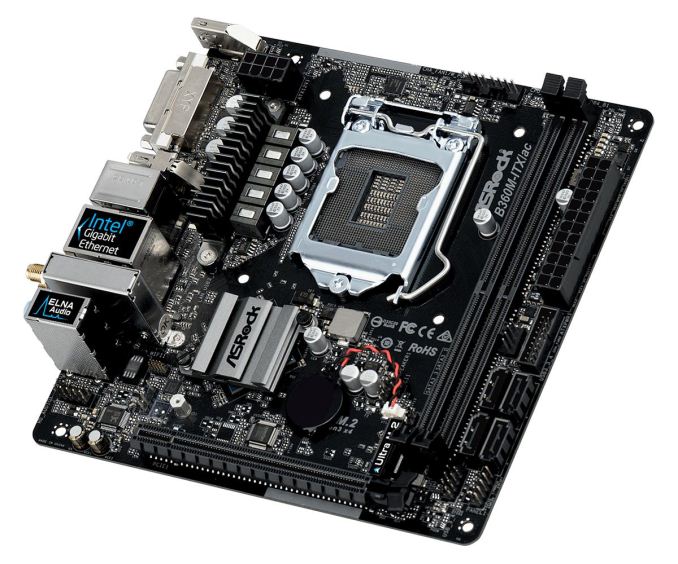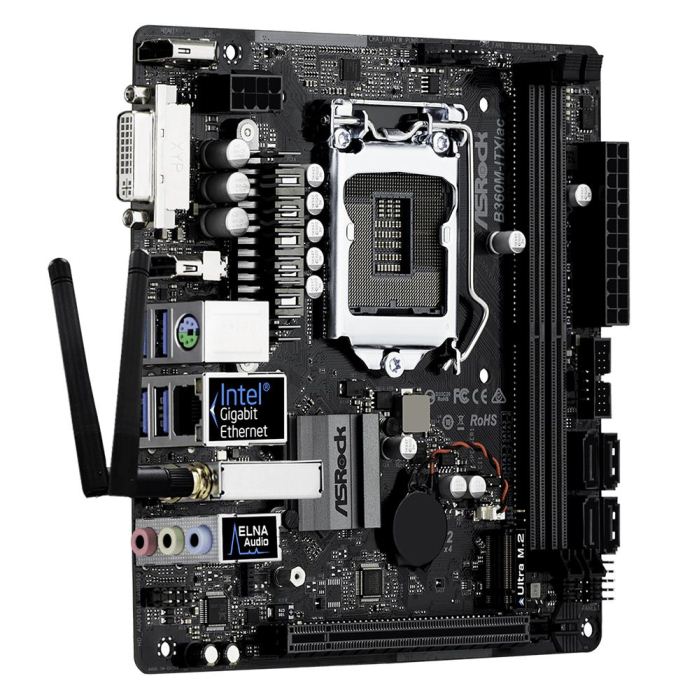The ASRock B360M-ITX/ac Motherboard Review: Tiny Take on B360, Sub $100
by Joe Shields on September 17, 2018 8:00 AM EST- Posted in
- Motherboards
- Intel
- ASRock
- Mini ITX
- 802.11ac
- Wi-Fi
- Coffee Lake
- i7-8700K
- B360
Conclusion
Any user looking to buy Mini-ITX motherboards are quite obviously looking for a small footprint and still would like to have at least some of the latest features included on the board. When users are looking at a mid-range chipset, they should expect that perhaps not all the features will make it on the board or in the quantity wanted, but such as it goes in the market.
The ASRock B360M-ITX/ac includes a lot of what users are looking for in this platform including USB 3.1 (10 Gbps) Type-A ports on the back, as well as a single M.2 port for SATA or PCIe based modules. The integrated Intel dual-band Wi-Fi adapter is capable of 433 Mbps speeds. This is a bit slower than what we see in many other boards (including two B360 Mini-ITX boards competing with it), however that speed should be plenty for most users. On the audio side of things, the Realtek ALC887 codec is used and supports 7.1ch surround.
As far as what may be improved on the board. It's a tough call. All users want all the features and at a low price, the latter what these boards are intended for. That said, I would like to have seen faster Wi-Fi module used, perhaps another M.2 slot, and dare I say, RGB LEDs or at least a header. That is hardware wise, but the elephant in the room was the multi-threaded performance and voltage regulator temperature throttling we are seeing. Boards should be able to handle any processor it says it has support for and this board simply couldn't do it, albeit in the most stressful of situations. Though understandably difficult with the limited space to work with, more USB ports of any type couldn't hurt. If a user has a USB mouse and keyboard, that leaves two on the back panel (in my case one as the G.Skill keyboard I use has two USB plugs).
On the aesthetics front, the board doesn't really set itself apart from the other similar offerings. It uses ASRock's Sapphire black colored motherboard but forgoes the use oF RGB LEDs and even RGB LED headers. Because of this, users will have to lean on their case, case fans, and other accessories to brighten things up a bit if they choose. Outside of that, it looks like every other B360 Mini-ITX board, function over form - not that the form is bad on any of these, it is what it is for reasons all board partners are limited by real-estate and cost considerations.
We've mentioned above there are concerns with heavily multi-threaded performance, which may be adjusted in future BIOS revisions, so we will focus on the positives. Single threaded performance and multi-threaded results without the ultra-stressful AVX instruction sets performed well compared to the other boards landing in the middle of the bell curve in most situations. So long as owners do not plan on rendering in Blender or POV-Ray, the motherboard handles things with aplomb.The ASRock B360M-ITX/ac really shined in boot times where it is currently the fastest board to get through POST I have tested so far.
In the end, the ASRock B360M-ITX/ac brings users a board with many features users expect to see in a SFF mid-range chipset based motherboard. Performance wise it works fine with an i7-8700K so long as it isn't being pushed terribly hard on all cores and threads with AVX instructions. All motherboards should be able to run any stock CPU it is compatible with and not throttle performance. We haven't had a chance to test the other boards, but if your use model includes rendering and such or using AVX instructions, you may want to look for a different solution or a processor with a lower TDP. We imagine few to purchase the 95W unlocked i7-8700K used in testing. So for those who are looking at the 65W locked CPUs, the B360M-ITX/ac can be a solid foundation for a small form factor build.
AnandTech Intel 300-Series Motherboard and CPU Coverage
- The Intel Core i7-8086K Review: Testing Intel's Anniversary 5.0 GHz Turbo CPU
- The Anandtech Coffee Lake Review: Initial Numbers on the Core i7-8700K and Core i5-8400
- Analyzing Z370 for Intel's 8th Generation Coffee Lake: A Quick Look at 50+ Motherboards
- ($397) The ASUS ROG Maximus X Apex Review [LINK]
- ($250) The NZXT N7 Z370 Review [LINK]
- ($191) The SuperO C7Z370-CG-IW Review [LINK]
- ($180) The ASRock Z370 Gaming-ITX/ac Review (LINK)
- ($180) The ASUS Z370-I Gaming Review [LINK]
- ($124) The GIGABYTE H370N WIFI Review [LINK]
- ($120) The GIGABYTE B360 Gaming 3 WIFI Review [LINK]
- ($102) The ASRock B360M-ITX/ac Review (this review)












23 Comments
View All Comments
katsetus - Monday, September 17, 2018 - link
So... It's not very good?Power delivery being overloaded by a "95 watt" CPU is not a good sign. Everyone knows that Intel's TDPs are by and large arbitrary numbers, especially motherboard engineers.
Although, I guess, same as you do, that this will not be paired with higher-end CPUs and neither will they be pushed to the limits. Still, a poor effort in my mind, especially for a B-series motherboard.
PeachNCream - Tuesday, September 18, 2018 - link
I'm thinking the 8700k is an outlier CPU in this motherboard under those particular workload conditions would be unusual. It's likely any of the non-K i5 and i3 processors equipped with a retail boxed cooler wouldn't exhibit the same problems when fully loaded. They're far more likely candidates for a motherboard in this price range anyway.Yeah, it the board should handle the workload better given its rated for a 95W chip, but it doesn't make a lot of sense to cheap out on the motherboard when trying to squeeze everything you can out of a K CPU.
Mr Perfect - Wednesday, September 19, 2018 - link
This makes me wonder how well it would do with an 8600 non-k. It's a little silly to get a Z3x0 overclocking chipset for a locked processor, so a B360 like this would have been worth considering.Yaldabaoth - Monday, September 17, 2018 - link
Page 8: " On the audio side of things, the Realtek ALC887 codec is used and supports 7.1ch surround. "Please educate me. How can this board support that with the audio I/O it provides? Doesn't it need more, or am I that behind the times?
katsetus - Monday, September 17, 2018 - link
*To configure 7.1 CH HD Audio, it is required to use an HD front panel audio module and enable the multi-channel audio feature through the audio driver.The jacks have 2 poles, so you get 4 channels from front panel.
Also a fun fact: ALC887 is now over 10 years old.
Yaldabaoth - Monday, September 17, 2018 - link
Thanks for that insight!kmi187 - Monday, September 17, 2018 - link
What I found funny about this chip is that it can sound extremely horrible, and also very good. A lot depends on how the manufacturer decided to implement the chip on the board and with what components. Since they usually end up in very cheap boards, not a lot attention is given so most people think they sound bad. Rightfully so, if you hear bad sound, it's probably bad. But then on other boards with the same chip, it can sound really nice.Now I'm not saying this is a great chip, it's average at best and that's all it ever will be. But how it's implemented on a board, defenitly makes a difference in the end result that you get to hear.
bigpondsupport - Tuesday, September 18, 2018 - link
For more details http://bigpondsupporthelp.strikingly.com/Samus - Monday, September 17, 2018 - link
The audio codec kills the board as an option for me. I'm looking to build an i5-8400 replacement for my FT03-mini still running an H87 Xeon V3 board. Basically I'd like NVMe M.2, native USB 3.1, and modern PCIe.But since ITX boards naturally only have ONE PCIe slot, every other component needs to be future-proof. The ALC 887 IS NOT future-proof. It's a terrible codec by modern standards. The SNR isn't competitive no matter how it is implemented.
The fact it struggled with a 95w CPU isn't all that surprising, but follows the theme of corner-cutting through this boards development. This would be a good board for $50-$60, because it's obviously the worst ITX board you can buy for Coffee Lake. At it's current price it's a no-brainer to just buy the ASUS for $20 more...
vlado08 - Monday, September 17, 2018 - link
I don't think there is a HDMI 2.0 on this board